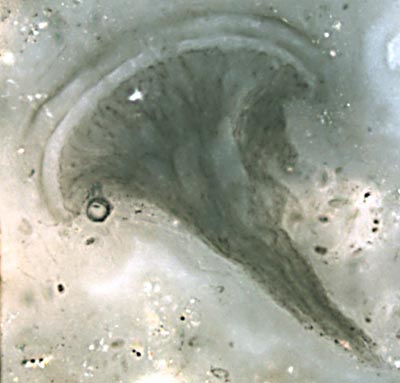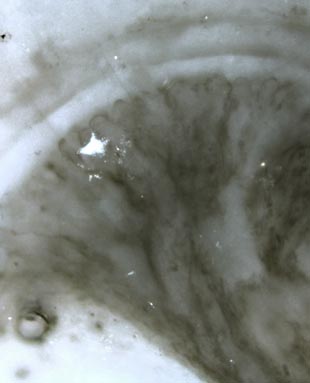Castracollis
eye ?

A Rhynie chert sample of 0.28kg found in 2003 has
successively provided rare and surprising details. A conspicuous one is
a large moult part of the crustacean Castracollis
(Fig.1), now less rare than at the time when it was first described
[1] and named after the farm Castlehill near Rhynie. There is fossil
evidence indicating that it might have grazed on tufts of the
filamentous cyanobacterium Croftalania.
Fig.1: Castracollis
moult part without head and shield, 28 segments seen, numerous legs
below. Image width 3.8mm.
Less conspicuous but nevertheless highly significant are the
spirals of a new variety of Nematoplexus,
discovered in 2009, twice as large as those of the type specimen first
described in 1961.
As another surprise, a quite uncommon and
probably phylogenetically
important charophyte
alga
discovered in 2015 has been found shortly afterwards in this sample,
too.


In 2016, the series of peculiarities has been continued with
an
object which might be a detached compound eye (Figs.2,3). In
view of
the several
Castracollis moult
parts in this
sample, one may conclude that it is a Castracollis eye,
provided that it is an eye at all. If so, this would be the first image
of such eye. Despite of the slightly
disarranged state, the top ends of the individual components are still
visible in Fig.3.
Figs.2,3: Compound eye (?) of Castracollis,
detached. Height of Fig.2: 0.3mm.
Photographs Figs.1-3: Gabriele Barkleit
H.-J. Weiss 2016
[1] S.R.
Fayers, N.H. Trewin : A new crustacean from the Early
Devonian Rhynie Chert ...
Trans. Roy. Soc. Edinburgh, Earth Sci.
93(2003): 355-382.
 |
 |
101 |






